
A while ago in my quest to gather pertinent books regarding the artistry of the World of Roubo, and in fact the larger portrait of the culture surrounding him (in part due to my desire to replicate the work, in part due to my ongoing efforts to write a novel for which one thread involves Parisian cabinetmaking c.1770), I went on a sustained book-buying spree. For the most part that spree has ended with only one or two exceptions, and my absence from abebooks.com has led them to send me a “Get Well Soon” card. Just kidding about that, but it had been a very long while before a recent purchase or two.
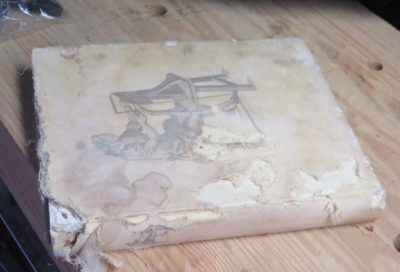
One of my last purchases perhaps three or four years ago was, at that time, a somewhat hard-to-find book that was equally hard-to-afford. While browsing my barn library a couple weeks ago a faint familiar stench prompted the memory of this book. When it first arrived and I opened the package I knew immediately why I could afford it. Yes, it was in poor physical condition, but I knew that already. What I did not know at the time was the someone had doused the volume with perfume, and I mean doused. It was probably to disguise up the odor of mildew or rodent urine/feces or who knows what. When I first opened it the perfume actually burned my eyes it was so strong.
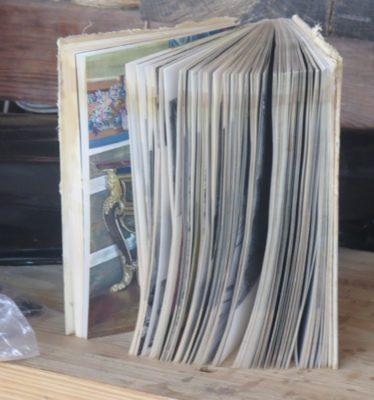
I bagged it back up and set it aside to deal with it “another day.” Since coming across it again, and desiring to actually read it without wearing a gas mask, I splayed it out on a bench way away from my work space. I checked it gain and it is still odoriferous. I think I will have to put it inside a sealed rubber tub with a lot of activated charcoal and probably swap out the charcoal a time or four to extract the stench enough for me to hold it at reading distance.
Peeeyuwww!
I’ll let you know how that goes.
Recently I have been spending some time trying to impose order and completion to the Barn library, which might be a fancy way of saying I have been throwing away boxes full of paperwork from my career at the Smithsonian. My departure was six years ago, and at this point I am pretty certain I no longer need any organizational files from that era. As a result I have about a dozen cubic feet of fire-starting material.

An unexpected(?) result of all this commotion has been that I’ve (re)discovered a number of things I have written over the years. Not Schwarzian by any measure, but a fair pile nonetheless. Articles in magazines, chapters of books, handouts for presentations, and monographs for newsletters, etc. While the Writings page of donsbarn.com already has a goodly number of these missives, there are even more that have not arrived there yet. So I have set up my ancient laptop and scanner to capture these electronically and make them ready to post both on the blog and in the “Writings” section.
I should have the first one ready to go in a couple days, and hope to post a new one each week.
Oh, and I am working on readying some more material for the Shellac Archive as well. I still have a full “banker’s box” of material to scan. All tolled I have about 8,000 pages of shellac stuff.
I just finished a few days of production of glazed doors for the library bookcases. It gives me all the more respect for those artisans to make acres of kitchen and bathroom cabinetry. I am not really set up for large scale joinery production, but great progress was made nevertheless.
 In following Occam’s Razor, the philosophical construct that suggests simplicity as the best answer to a convoluted question, I decided to make exceedingly simple glazed doors using the pile of southern yellow pine I had left over from the barn flooring along with a dozen or so sheets of plexiglass from a house project that never materialized (it actually evolved into a much better one). Of course I overlooked the inverse of Occam’s Razor, namely that the simpler the structure, the greater the need for skillful design and execution.
In following Occam’s Razor, the philosophical construct that suggests simplicity as the best answer to a convoluted question, I decided to make exceedingly simple glazed doors using the pile of southern yellow pine I had left over from the barn flooring along with a dozen or so sheets of plexiglass from a house project that never materialized (it actually evolved into a much better one). Of course I overlooked the inverse of Occam’s Razor, namely that the simpler the structure, the greater the need for skillful design and execution.
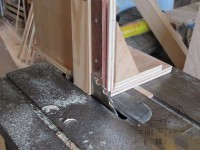 My plan was to build open faced mortise and tenon corners (bridle joints) using my table saw to cut all the joints. In principle the idea was fine, but in practice, let’s just say that a $25 saw from Craigslist is probably not the one you want for such a process (especially when the fence is such a piece of garbage it almost isn’t even worth the effort to throw it out the door). But, it was what I had on hand. My Unisaw was back in Maryland, along with my home-built but perfectly useable tenoning jig.
My plan was to build open faced mortise and tenon corners (bridle joints) using my table saw to cut all the joints. In principle the idea was fine, but in practice, let’s just say that a $25 saw from Craigslist is probably not the one you want for such a process (especially when the fence is such a piece of garbage it almost isn’t even worth the effort to throw it out the door). But, it was what I had on hand. My Unisaw was back in Maryland, along with my home-built but perfectly useable tenoning jig.
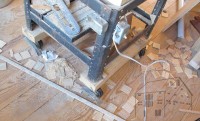 The first thing I needed to do was make a simple tenoning jig, which I did. Then, I cut all the open mortise shoulders on the rails, which were purposefully 1/2″ wider than the stiles. This went smoothly. I was left with several score of identical wooden tiles, which I gathered to save for the myriad times I need a small shim or spacer.
The first thing I needed to do was make a simple tenoning jig, which I did. Then, I cut all the open mortise shoulders on the rails, which were purposefully 1/2″ wider than the stiles. This went smoothly. I was left with several score of identical wooden tiles, which I gathered to save for the myriad times I need a small shim or spacer.
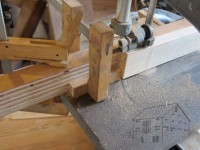 Cutting the open tenons was not so easy as the tenon length, corresponding to the wider rail, was deeper than the saw blade could cut when fully exposed by almost a half an inch. Grrr.
Cutting the open tenons was not so easy as the tenon length, corresponding to the wider rail, was deeper than the saw blade could cut when fully exposed by almost a half an inch. Grrr.
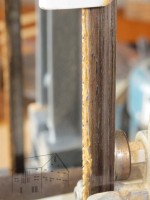 Quickly I set up the band saw to make the necessary shoulder cuts and it went fairly smoothly. Near the end things began to bog down a bit, and you can see why here. Even though well dried (almost three years for 5/4 stock) the rosin in the southern yellow pine was so gooey it clogged the 3/4″ 4 tpi blade. The only reason it worked as long as it did was the friction kept the rosin soft, so the saw blade could still do its work. Once I stopped the pitch cooled and hardened into a rock. I will either need to clean the blade completely or throw it away. Fortunately it is not my only blade.
Quickly I set up the band saw to make the necessary shoulder cuts and it went fairly smoothly. Near the end things began to bog down a bit, and you can see why here. Even though well dried (almost three years for 5/4 stock) the rosin in the southern yellow pine was so gooey it clogged the 3/4″ 4 tpi blade. The only reason it worked as long as it did was the friction kept the rosin soft, so the saw blade could still do its work. Once I stopped the pitch cooled and hardened into a rock. I will either need to clean the blade completely or throw it away. Fortunately it is not my only blade.
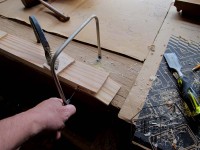 Since the glazing was 1/8″ plexi, and I like fully housed glazing, I ripped an off-center groove on the inside edges of all the door elements into which I would insert the glazing. In retrospect I should have been more careful to line up the groove with the outer edge of the tenon. It would have made the fitting of the corners a lot cleaner, but then so would a well-performing table saw.
Since the glazing was 1/8″ plexi, and I like fully housed glazing, I ripped an off-center groove on the inside edges of all the door elements into which I would insert the glazing. In retrospect I should have been more careful to line up the groove with the outer edge of the tenon. It would have made the fitting of the corners a lot cleaner, but then so would a well-performing table saw.
 I moved to the work bench, my first Roubo model, and trimmed the shoulders of the tenons and cut the blanks from the open mortises with a coping saw. It literally took only ten or fifteen seconds per mortise. Most of the corners fit together without further attention, a few needed a handful of strokes with the rabbet plane for them to slip together.
I moved to the work bench, my first Roubo model, and trimmed the shoulders of the tenons and cut the blanks from the open mortises with a coping saw. It literally took only ten or fifteen seconds per mortise. Most of the corners fit together without further attention, a few needed a handful of strokes with the rabbet plane for them to slip together.
I then glued the frames together with the plexi sheet inserted, and when dry they were ready for trimming and installation.
 As a sop to motivational psychology, I temporarily installed two pairs of the doors and filled the cases with books. This fatuous gesture was very encouraging. When I return probably at the end of the month I will assemble the remaining doors, and finish the detailing of all the doors before I install them and load the units with boatloads of books.
As a sop to motivational psychology, I temporarily installed two pairs of the doors and filled the cases with books. This fatuous gesture was very encouraging. When I return probably at the end of the month I will assemble the remaining doors, and finish the detailing of all the doors before I install them and load the units with boatloads of books.














Recent Comments